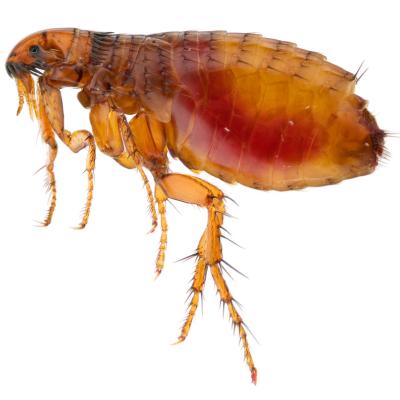Fleas are parasitic insects that survive by feeding on the blood of their hosts. They’ve been around for millions of years — and yes, some scientists believe they even fed on dinosaurs! Today, the most common flea species in the United States is the cat flea. Despite its name, this flea doesn’t just affect cats — it’s also found on dogs, humans, raccoons, ferrets, skunks, and even birds.
About Fleas
Fleas are tiny, blood-sucking pests that can cause big problems for both people and pets. Known for their jumping ability and itchy bites, fleas are most commonly introduced into homes by dogs, cats, or wildlife passing through your yard. Once inside, they can multiply quickly and become difficult to eliminate without targeted treatment.
These pests aren’t just annoying; they can also pose health risks. Fleas are capable of transmitting bacteria, tapeworms, and other parasites. Even a small infestation can lead to itching, discomfort, and skin irritation for pets and people alike.
What Do Fleas Look Like?
Fleas are tiny, but their appearance is distinct once you know what to look for. Because they’re so small and move quickly, spotting them can be tricky; especially if they’re hiding in pet fur, carpets, or furniture.

Here’s how to identify a flea:
- Size: Adult fleas are very small — usually about 1/16 to 1/8 of an inch long (around the size of a sesame seed).
- Color: They’re reddish-brown or dark brown in color.
- Shape: Fleas have flat, narrow bodies, which helps them move easily through fur or feathers.
- Legs: They have six long legs, with powerful back legs designed for jumping. Fleas can leap up to 7 inches vertically!
- No wings: Fleas are wingless, so they don’t fly — but their jump more than makes up for it.
- Hard shell: Their bodies are tough and slippery, making them difficult to crush.
Fleas are most commonly seen hopping on pets or crawling through their fur. You may also notice flea dirt (tiny black specks of dried blood) on your pet’s skin or in areas where they sleep.
What Are The Characteristics of Fleas?
Fleas may be small, but they’re built for survival. Once they get into your home, they can be tough to control. Understanding their physical traits and behaviors helps explain why flea problems can escalate quickly.
Here’s what makes fleas unique:
- Incredible Jumpers: Fleas have strong back legs that allow them to jump over 100 times their body length. This helps them move easily between hosts or from carpets to pets.
- Blood Feeders: Fleas survive by feeding on the blood of mammals and birds. They often bite multiple times in one feeding session.
- Hard, Flat Bodies: Their thin, hard exoskeleton makes them difficult to crush, and their flattened shape helps them slip through pet fur and feathers unnoticed.
- Rapid Reproduction: A single female flea can lay up to 50 eggs per day. These eggs fall off the host and spread into carpets, bedding, and furniture.
- Sensitive to Movement and Heat: Fleas detect warmth and vibrations to locate nearby hosts, making them quick to jump when a person or pet walks by.
- Lifecycle Flexibility: Fleas can pause their development if conditions aren’t right, allowing them to survive for weeks or even months before emerging as adults.
What Are The Habits of Fleas?
Fleas have a predictable set of habits that help them survive, reproduce, and spread quickly, especially when pets or wildlife are involved. While their physical characteristics help them thrive, it’s their behaviors that keep infestations going if not addressed quickly.
Here’s what you should know about flea habits:
- Host-Seeking Behavior: Fleas rely on warmth, movement, and carbon dioxide to locate a host. They’ll patiently wait on the carpet, bedding, or in outdoor shaded areas for a person or animal to pass by.
- Frequent Biting: Once they find a host, fleas feed multiple times a day. Their bites can cause itchy welts on pets and humans alike.
- Egg-Laying Cycle: After feeding, female fleas begin laying eggs, usually within 24 to 36 hours. Most eggs fall off the host and settle into rugs, furniture, and cracks in the floor.
- Preference for Humid Conditions: Fleas thrive in warm, humid environments. Indoor infestations tend to get worse during the summer and early fall.
- Staying Close to Hosts: Fleas don’t wander far from their food source. They’ll spend most of their adult life on pets, while eggs, larvae, and pupae develop nearby in the environment.
- Hiding in Soft Surfaces: Larvae and eggs are often hidden in carpet fibers, pet bedding, baseboards, and upholstery — areas that are difficult to clean thoroughly without treatment.
Flea habits make them highly successful at hiding, spreading, and surviving in homes with pets. That’s why professional pest control is often the fastest and most effective way to break the cycle.
What Are The Risks of a Flea Infestation?
Fleas may be tiny, but an infestation can lead to big problems, especially if it goes untreated. Beyond being a nuisance, fleas can pose health risks to both people and pets, and their ability to multiply quickly makes the situation even more serious.
Here are the key risks of having fleas in your home:
- Itchy, uncomfortable bites: Flea bites are small, red, and incredibly itchy. They often appear in clusters on the ankles, legs, or around the waist.
- Skin irritation for pets: Fleas can cause allergic reactions in pets, leading to scratching, hair loss, hot spots, and skin infections.
- Disease transmission: Fleas are capable of spreading harmful bacteria and diseases, such as murine typhus and cat scratch fever. Historically, they were also responsible for spreading the plague.
- Tapeworms: Fleas can carry tapeworm larvae. If a pet accidentally swallows an infected flea while grooming, they can become infected.
- Rapid infestation spread: A single flea can lay dozens of eggs per day. Eggs drop into carpets, bedding, and upholstery, allowing the infestation to spread throughout the home.
- Emotional stress: Ongoing flea problems can create stress, sleeplessness, and frustration for homeowners trying to manage the issue on their own.






